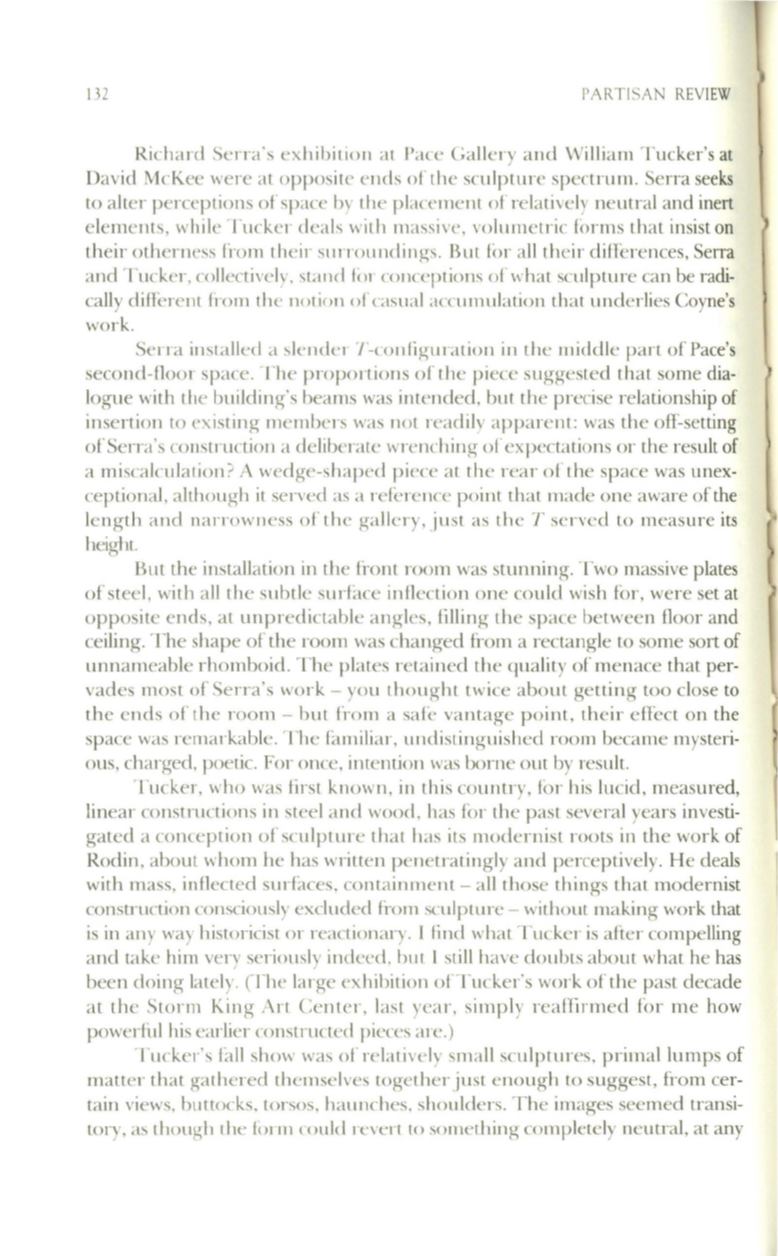
132
PARTISAN REVIEW
Richard Serra's exhibition at Pace Ga llery and Wi ll iam Tucker's at
David McKee were at opposite ends of the scu lpture spectrum. Serra seeks
to alter perceptions of space b" the placement of relatively neutral and inert
elements, while Tucker deals with massive, volumetric f()rms that insist on
their otherness fi'om their surroundings. But fi)r a ll their di fIerences, Serra
and Tucker, collectively, stand fill conceptions of what sculpture can be radi–
cally different li'om the notion
or
casual accumu lation that underl ies Coyne's
work.
Serra installed a slender T-configu ration in the midd le pan of Pace's
second-floor space. The proportions of the piece suggested that some dia–
logue with the building's beams was intended, but the precise relationship of
insertion to existing members was not readilv apparent: was the
ofl~setting
of Serra's cOllstruction a deliberate wrenching of expectations or the result of
a miscalculation? A wedge-shaped piece at the rear of the space was unex–
ceptional, although it served as a reference point that made one aware of the
length and narrowness of the gallery, just as the
T
served to meas ure its
height.
But the installation in the (i'ont room was stunning. Two massive plates
of steel, with all the subtle surface inflection one cou ld wish for, were set at
opposite ends, at unpredictable angles, filling the space between floor and
ceiling. The shape of the room was changed fi'om a rectangle to some sort of
unnameable rhomboid. The plates retained the quality of menace that per–
vades most of Serra's work - you thought twice about getting too close to
the ends of the room - but from a safe vantage point, the ir effect on the
space was remarkable. The
f~lll1iliar,
undistinguished room became mysteri–
ous, charged, poetic. For once, intention was borne out by resu lt.
Tucker, who was first known, in th is country, for his lucid, measured,
linear constructions in steel and wood, has for the past several years investi–
gated a conception of sculpture that has its modernist roots in the work of
Rodin, about whom he has written penetratingly and perceptively. He deals
with mass, inflected surfaces, containment - all those things that modernist
construction consciously excluded from sculpture - without making work that
is in any way historicist or reactionary. I find what Tucker is after compelling
and take him very seriously indeed , but I still have doubts about what he has
been doing lately. (The large exhibition of"Tucker's work of the past decade
at the Storm King Art Center, last year, simply reaflirmed for me how
powerfi.t1 his earlier constructcd picces are.)
Tucker's fall show was of" relatively small sculptures, primal lumps of
matter that gathered themselves together just enough to suggest, from cer–
tain views, buttocks, torsos, haunches, shoulders. The images seemed transi–
tory, as though the limn could reven to something completely neutral, at any


